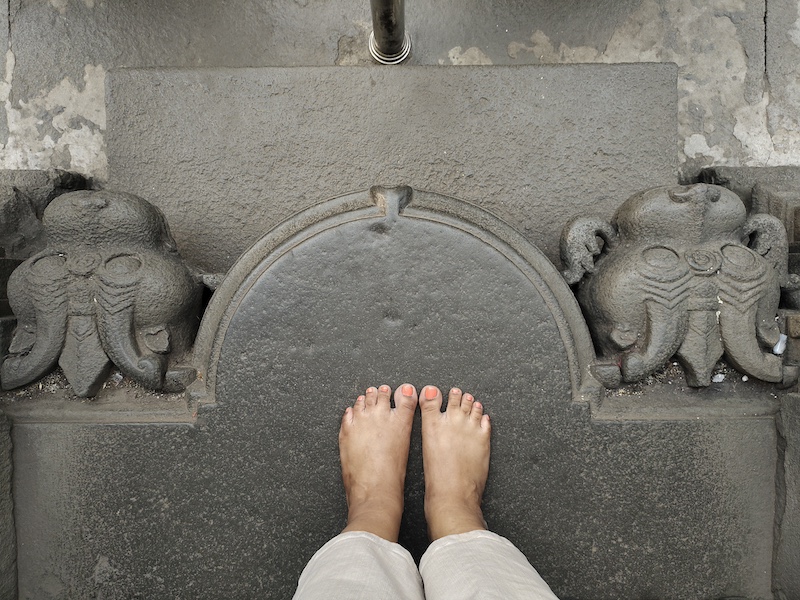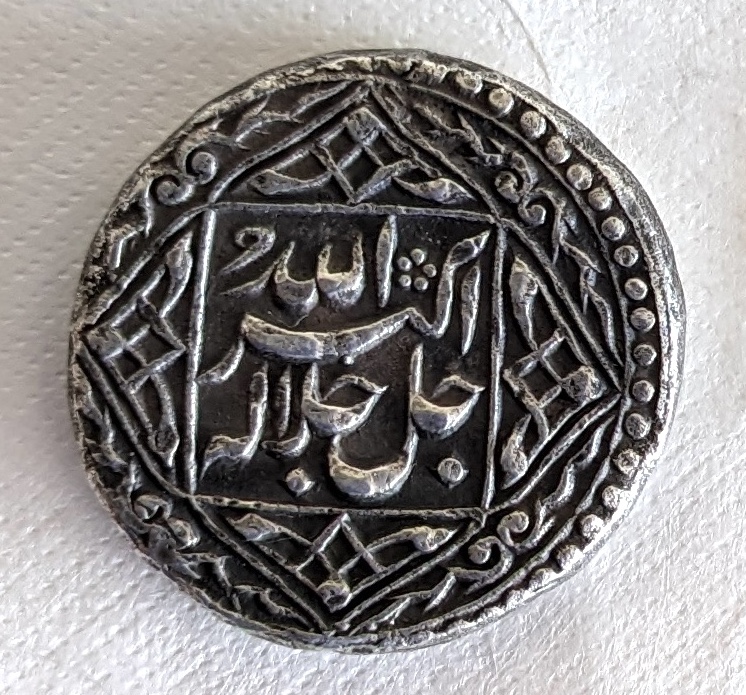Throughout the medieval period in India—roughly 6th to 16th Century—enterprising dynasts tried to conquer the rocky, arid expanse of the Deccan plateau for the promise of what lay beneath: rich veins of minerals and gemstones. So they ventured into this land, created some 66 millions years ago by a volcanic eruption that left behind forbidding walls of basalt rock and jagged sandstone cliffs. And they chiselled temples from monoliths and sent enormous domes soaring into the sky. Their legacy is medieval Deccani architecture, which encompasses the gamut from intricate Dravidian temple sculptures to elegant Indo-Islamic minarets to rock-hewn monasteries of austere grace.
Of living rocks & elephant charms
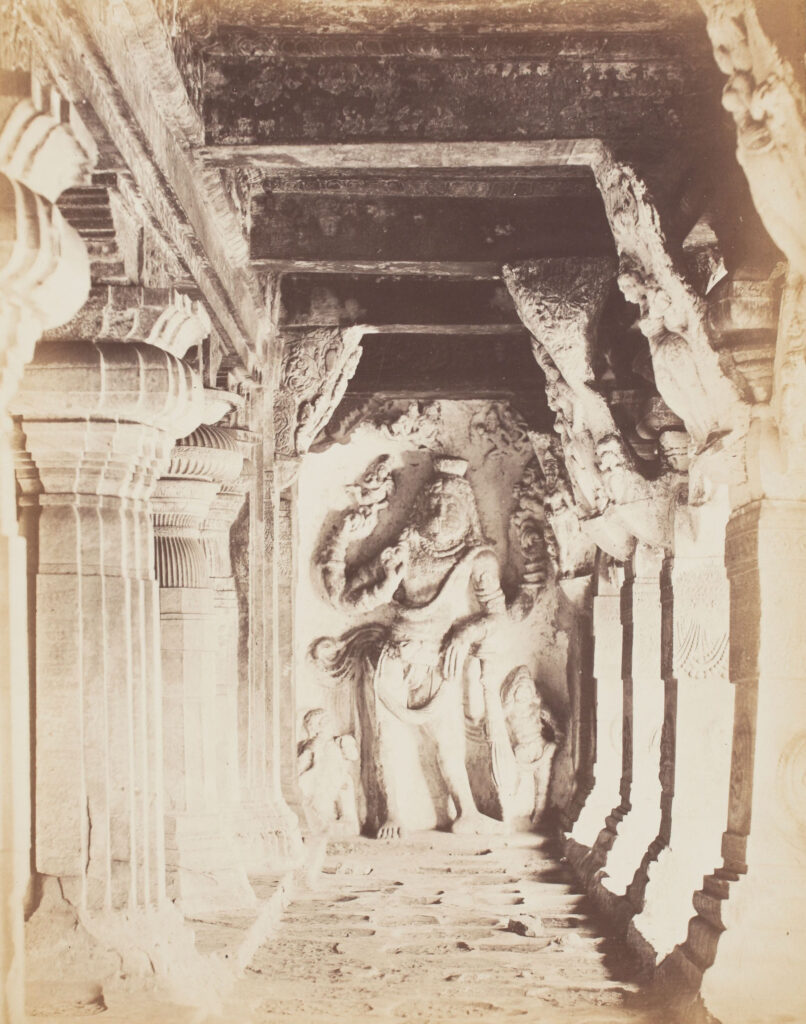
‘Badami – Veranda of Cave iii from the east end’, 1874, image © Sarmaya Arts Foundation
A mix of Nagara and Dravida styles, rock-cut cave temple architecture originated and flourished under the Chalukyas (6 to 12 CE) across the towns of Badami, Aihole and Pattadakal in northern Karnataka. Having ruled over the Deccan for over 600 years, they had an outsized role to play in the development of southern Indian architecture. They built Shaivite, Vaishnavite and Jain temples using a technique known as ‘subtraction’, where the structure was not built as much sculpted out of living rock formations. The cave temples at Badami are carved into the slopes of an imposing red sandstone hill. Inside, elaborate sculptures narrating tales of the greatness of Lord Shiva and Vishnu look over the cliff and onto Lake Agastya below.
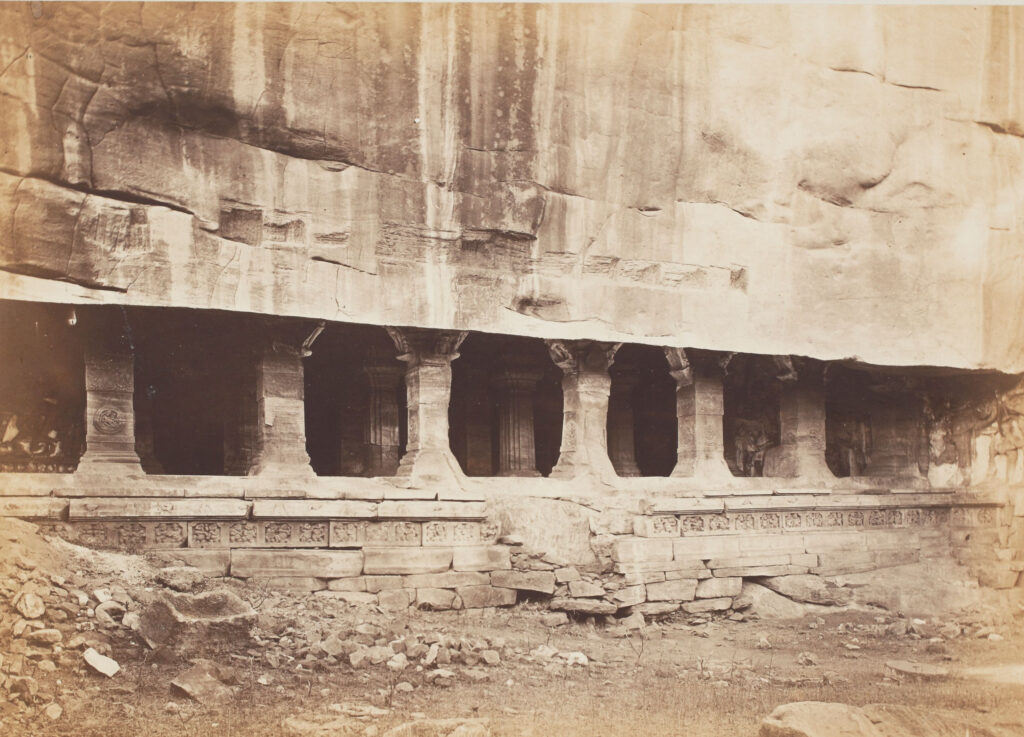
‘Badami- Front of Cave iii from the northeast’, 1874, image © Sarmaya Arts Foundation
The notable Durga temple at Aihole with its semi-circular façade, known as the Gajaprasta style (the back of an elephant), is among the most enduring monuments of the Chalukya empire. While originally built as a temple dedicated to the sun god Surya, the Durga temple at Aihole was later fortified during the 13th-century wars between the Hindu kingdoms and the Islamic Sultanates. This fortification earned it the moniker of ‘durg’, meaning fortress. According to architectural scholar Dr George Michell, the aesthetic experimentation that began at Aihole eventually yielded the extraordinary temple complex of Pattadakal.
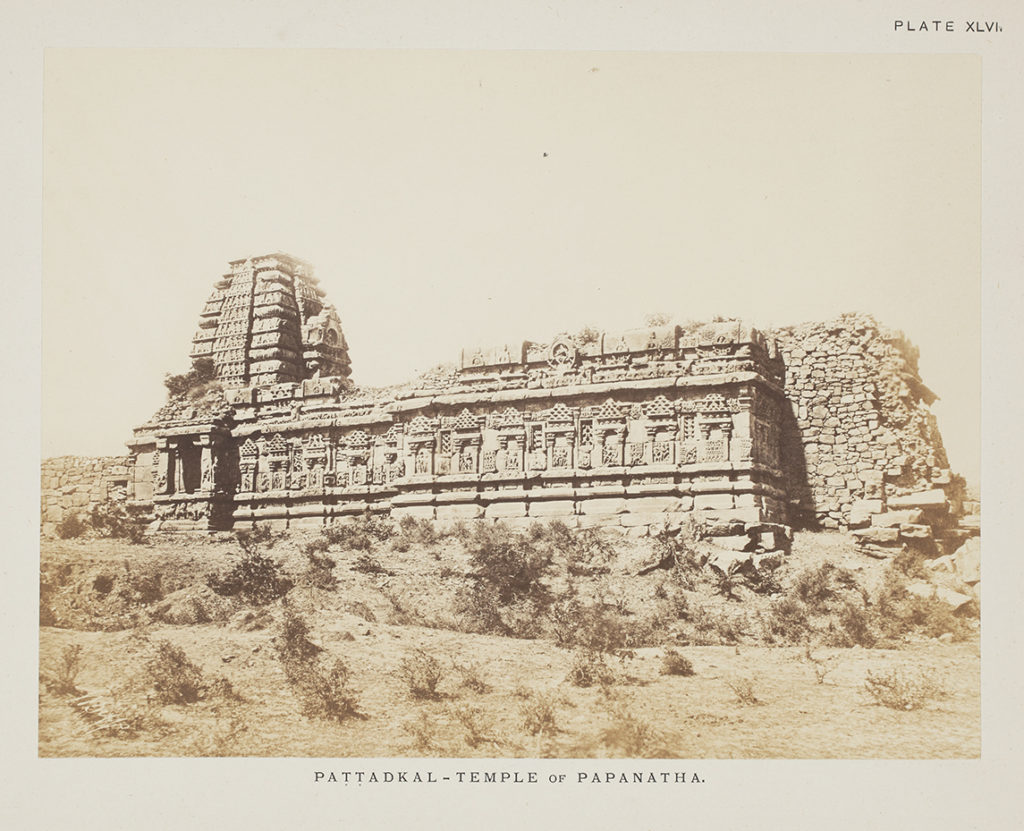
Papanatha Temple, Pattadakal, 1856, Thomas Biggs, image © Sarmaya Arts Foundation
Magnificent monoliths
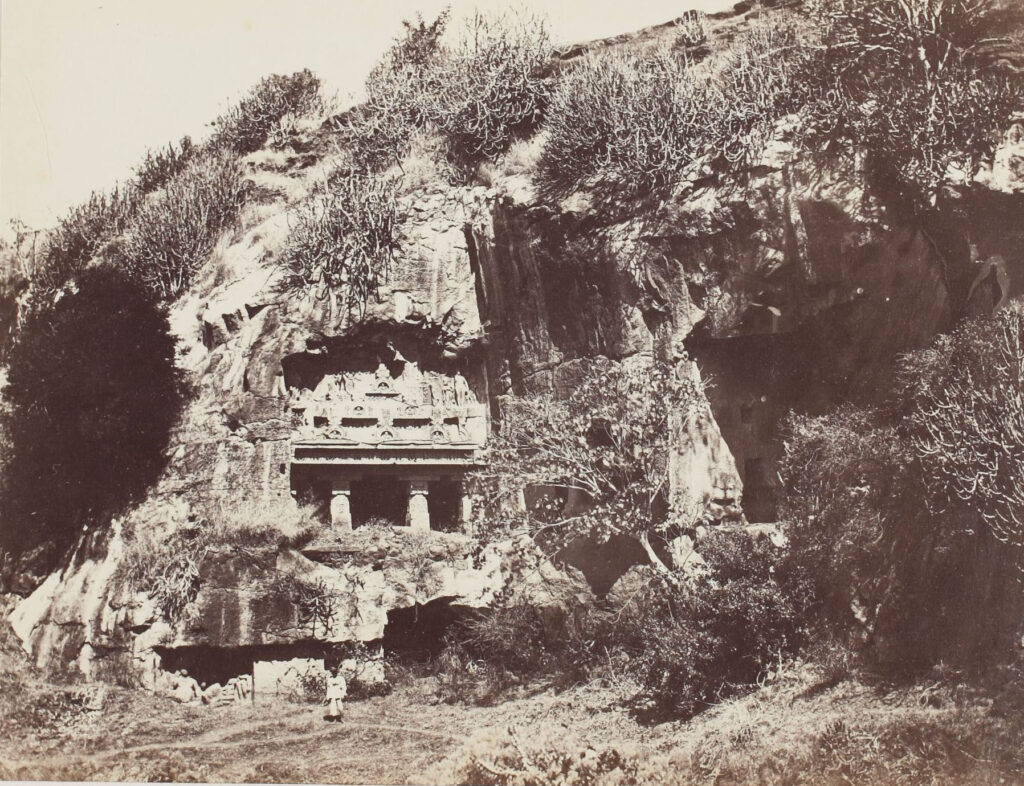
Ellora, India Album, 1850-1870, image © Sarmaya Arts Foundation
The Rashtrakutas (6th to 10th Century) proved to be worthy successors of the rock-cut architectural tradition. Some would argue the craft attained its zenith under their patronage, in the form of the 8th-Century Kailasha Temple of Ellora. The most celebrated of the cave temples in this complex, it was carved from one massive block of rock—a 200-foot-long, 100-foot-wide, 100-foot-tall monolith. It is theorised by archaeologist and historian MK Dhavalikar that Rashtrakuta king Krishna I brought the sculptors and architects of the Pattadakal temples, and some Pallava artists, to his territory and engaged them in the construction of the Kailasha temple at Ellora. Hence the heavy influence of Chalukya and Pallava aesthetics in its design.
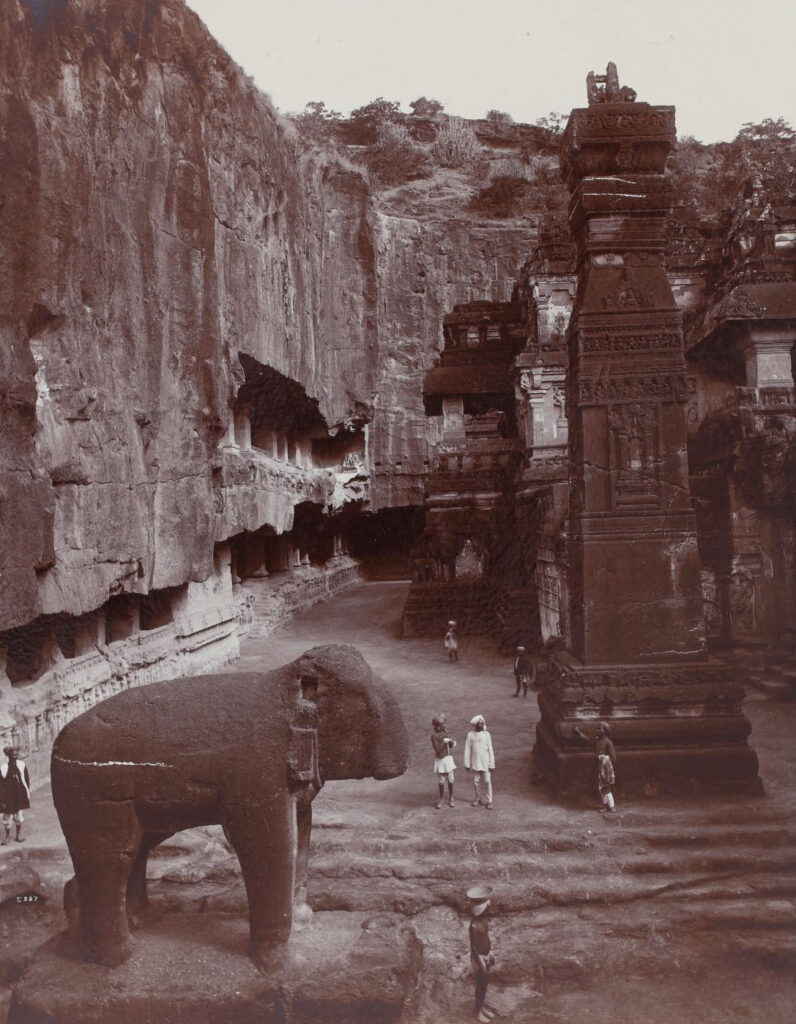
‘Kailas Cave. Right Side’, c.1880s, Lala Deen Dayal & Sons, image © Sarmaya Arts Foundation

‘Battle Scene In The Kailas Rock-cut Temple’, c.1880s, Lala Deen Dayal & Sons, image © Sarmaya Arts Foundation
Sculpted sagas
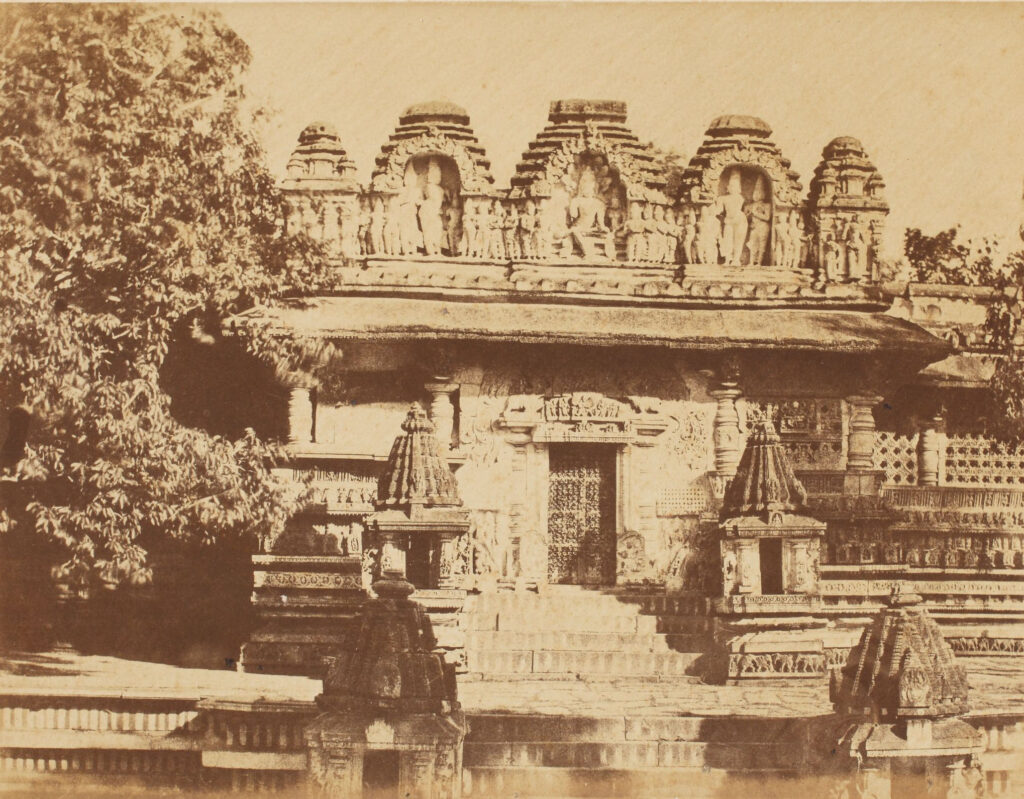
Chennakeshava Temple, Belur, 1856, ACB Neill, albumen print, image © Sarmaya Arts Foundation
The Hoysalas were vassals of the Western Chalukyas, whose architectural influence they built upon and eventually surpassed in artistry. After gaining autonomy, the Hoysalas (11th-14th Century) commissioned far more decorative and ornate structures, thus establishing a visual language that was uniquely theirs. They engaged local artists and craftsmen to cover their temples with meticulously wrought carvings. Sculptors were able to achieve remarkable fineness of details in soft soapstone.
Commissioned in 1117 CE, the Chennakesava temple at the erstwhile capital of Belur, 220 km from Bangalore, is an example of the earlier Hoysala architecture, still informed by the sensibilities of the Western Chalukyas. The temple stands on an open and wide platform designed to be a circumambulatory path around the sanctum, with a complex profusion of sculptures and storytelling panels decorating every part of the structure.

From the Hoysaleshwara temple, Halebidu, 1856, Dr Pigou © Sarmaya Arts Foundation
On the other hand, the Hoysaleshwara temple at Halebidu is regarded as the peak of the empire’s architectural achievement. Tales from the Ramayana and Mahabharata are told in elaborate detail in the friezes set along the temple’s walls. Hoysala architecture also contained an element of the erotic, associated with Shakta practice. These sensual themes are explored discreetly through carvings in the recesses and niches of the Temple.
Temples of art
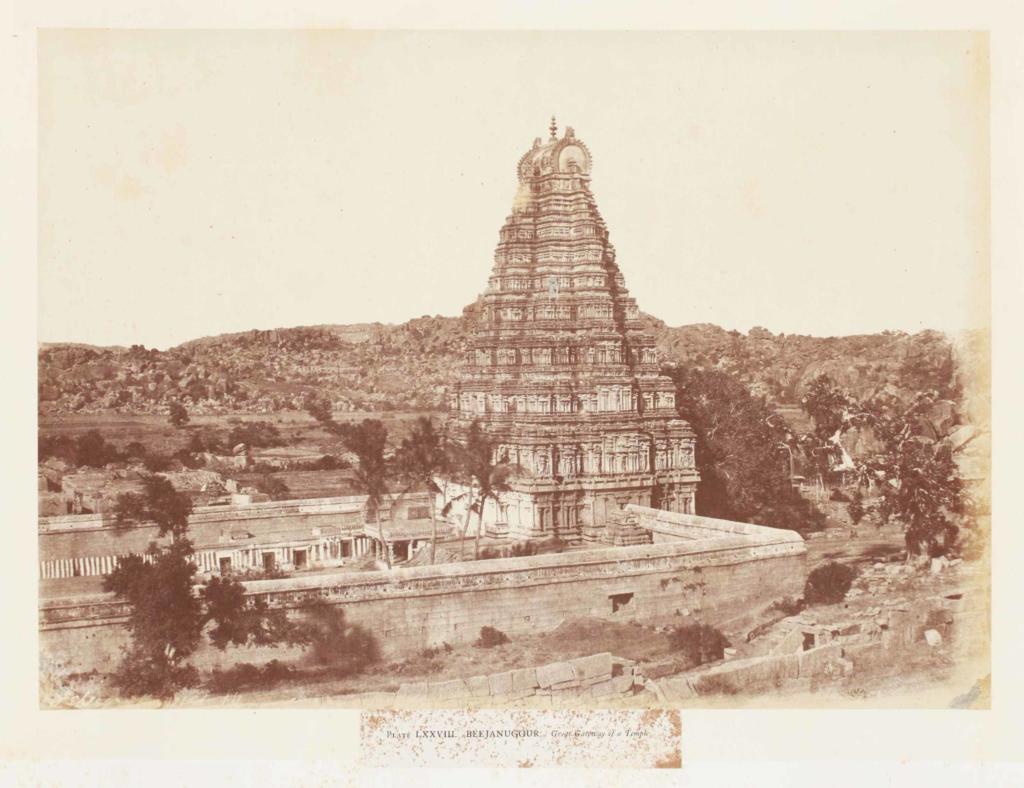
‘Great Gateway of a Temple, Beejanugger’–Virupaksha Temple, c 1856, Dr Pigou, image ©️ Sarmaya Arts Foundation
Visitors entering the historic town of Hampi in northern Karnataka are even today greeted by the view of gargantuan, tumbling boulders. Rising from this otherworldly terrain is a towering gopuram, welcoming you to the Virupaksha temple and to Hampi itself. This temple to Lord Shiva is believed to be the nucleus around which the city grew and prospered during the Vijayanagara era (14th– 17th Century).
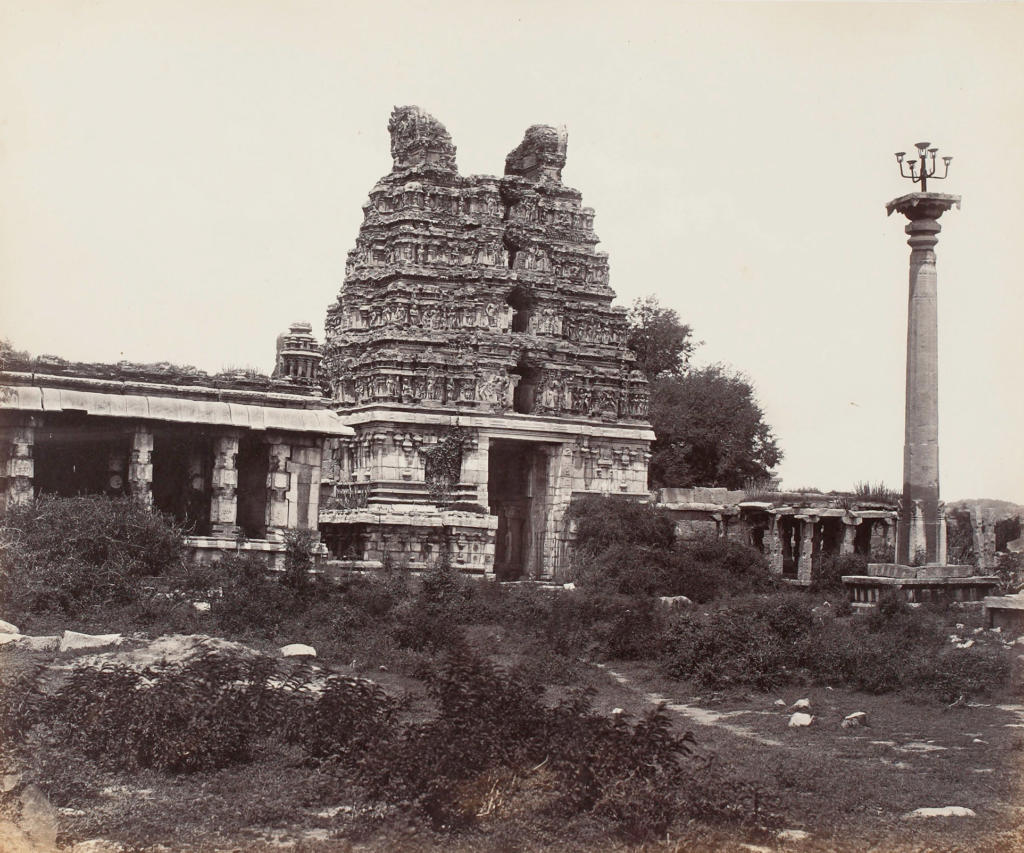
‘Gopuram Entrance to the Vijaya Vithala Temple’, Hampi, c. 1865-1869, Edmund David Lyon, image © Sarmaya Arts Foundation
A slew of other sprawling temple complexes dot the landscape of Hampi, which sits along the banks of the Tungabhadra river. The Krishna and Vittala temples are also structured like the Virupaksha, with carved pillars; pushkarnis or stepwells hinting at the aridity of the region; and kalyana mandapams, where the wedding ceremonies of the gods are performed every year. Leading up to the temples are bazaar roads with colonnaded arcades, where diamonds, textiles and spices were once sold. The Vittala temple boasts a grand stone chariot dedicated to Garuda, and 56 ingeniously engineered musical pillars that resound pleasingly when tapped. Hampi was abandoned after 1565, when the Vijayanagara empire was defeated by the five empires of the Deccan Sultanate: Berar, Bidar, Ahmadnagar, Bijapur and Golconda.
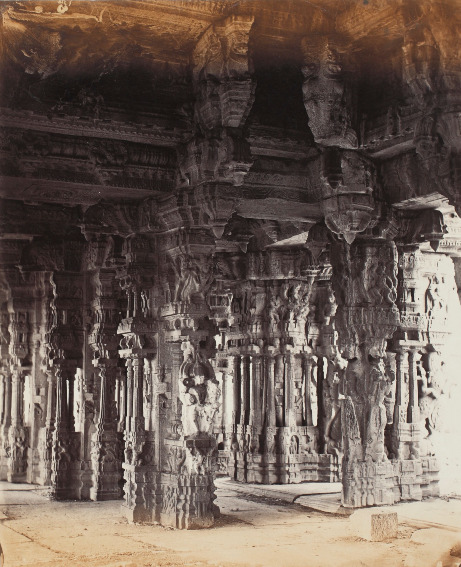
Interior of the Vitthala temple, Hampi, c. 1865-1869, Edmund David Lyon, image ©️ Sarmaya Arts Foundation
Painted palaces

Tiger and sun emblem at the Takht Mahal, from the rare book ‘Bidar, Its History and Monuments’, 1947, G Yazdani, image © Sarmaya Arts Foundation
Bidar in the north-east tip of Karnataka became the capital city of the Bahmani kingdom when Sultan Ahmed Shah I shifted his capital here from Gulbarga (now Kalaburagi) in about 1425. The Bidar fort, earlier captured by the Tughlaq dynasty from the Kakatiyas, was then rebuilt to reflect its stature as the seat of Bahmani power. Featuring a six-mile wall made of huge red laterite stone blocks and a rare triple moat, the fort complex contains various palaces and communal spaces, such as the Takht Mahal, the Solah Khamba Masjid, the Shahi Hamam and Malbakh (royal baths and kitchens). But most notably, Bidar Fort houses Rangeen Mahal, named for its colourful tiles and artwork. The walls of the Rangeen Mahal are adorned with the finest of mother-of-pearl inlaid in jet black stone with floral patterns and calligraphic texts.
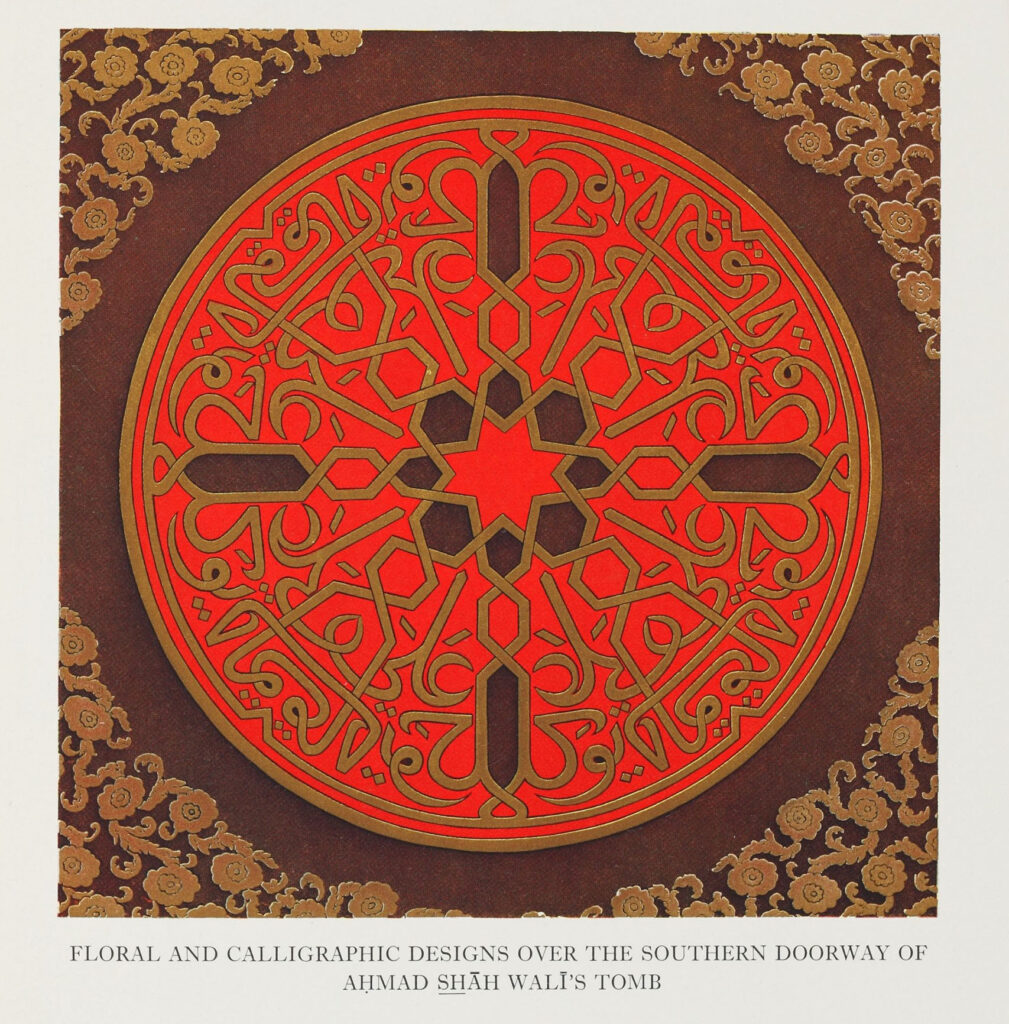
From the rare book ‘Bidar, Its History and Monuments’, 1947, G Yazdani, image © Sarmaya Arts Foundation
Grand domes

Gol Gumbaz, Bijapur, James Fergusson, image © Sarmaya Arts Foundation
The final resting place of Mohammed Adil Shah, seventh Sultan of the Adil Shahi dynasty, is an impressive feat of engineering. Gol Gumbaz is believed to be the largest dome unsupported by pillars in all of Asia and second largest in the world after St Peter’s Basilica in the Vatican. Situated in Karnataka’s Vijayapura or Bijapur city, this nearly 400-year-old monument doesn’t get the attention it deserves despite being almost twice the size and scale of the Taj Mahal. The dome sits at the centre of four tall twirling minarets, carved from local basalt with staircases leading to the top. The inside balcony is dubbed the ‘Whispering Gallery’, as even the faintest whisper travels from one end of the Gallery to the other.
Pineapples & precious stones
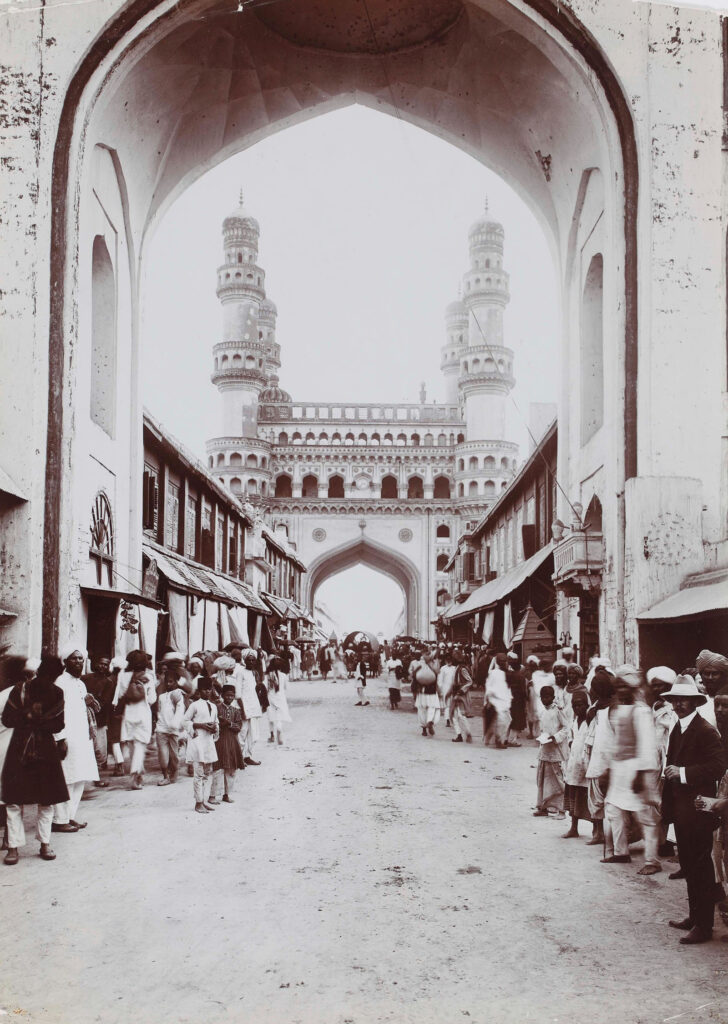
Charminar, Hyderabad, late 19th-early 20th century, image © Sarmaya Arts Foundation
The Qutb Shahis who ruled the empire of Golconda—and its mines—were owners of the world’s most spectacular cache of diamonds and gemstones. They used this wealth to build a spectacular tower and, around it, establish the city of Hyderabad. One of India’s most recognisable monuments, the Charminar is named for its four minarets that rise to a height of 56 metres.
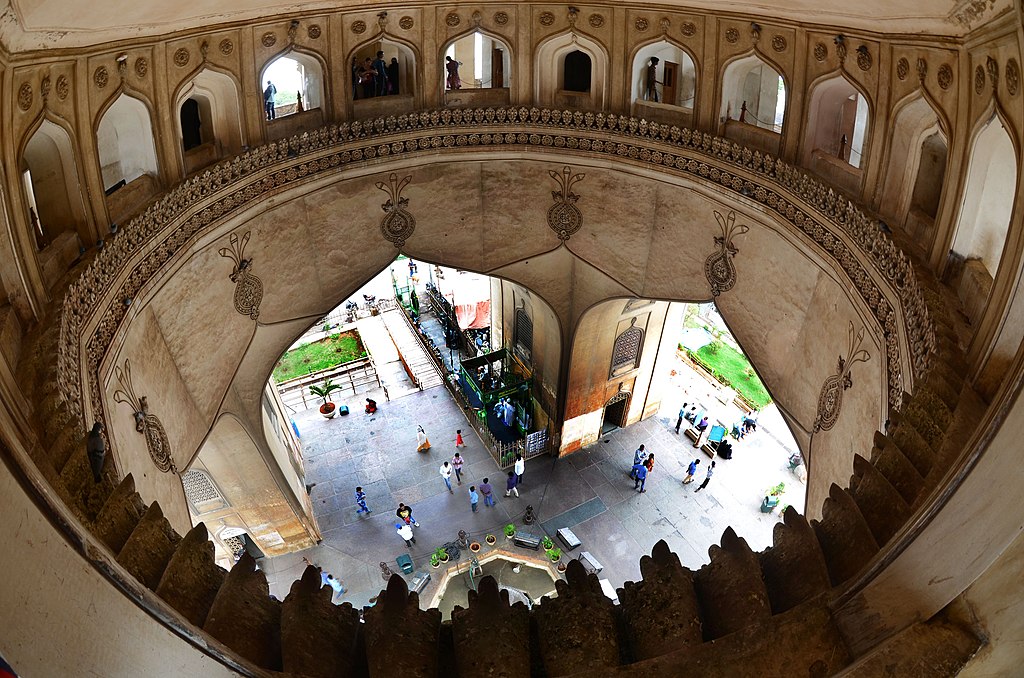
Stucco-work pineapples inside the Charminar, image by Prashant Kharote/Wikipedia Commons/CC BY-SA 4.0
It is adorned in places with a charming pineapple motif, meant to symbolise the wealth, sophistication and generosity of its royal patrons. Pineapples also find their way onto the imposing domes of the Qutb Shahi tombs. The Badshahi Ashoorkhana stands near the Charminar and was built not long after it. It continues to serve as a place where Shia Muslims gather during Muharram to mourn the killing of Prophet Mohammed’s grandson, Imam Husain, in the Battle of Karbala. The 400-year-old Ashoorkhana features intricate coloured mosaics depicting the ceremonial battle standard or alam with exquisite Thuluth calligraphy.
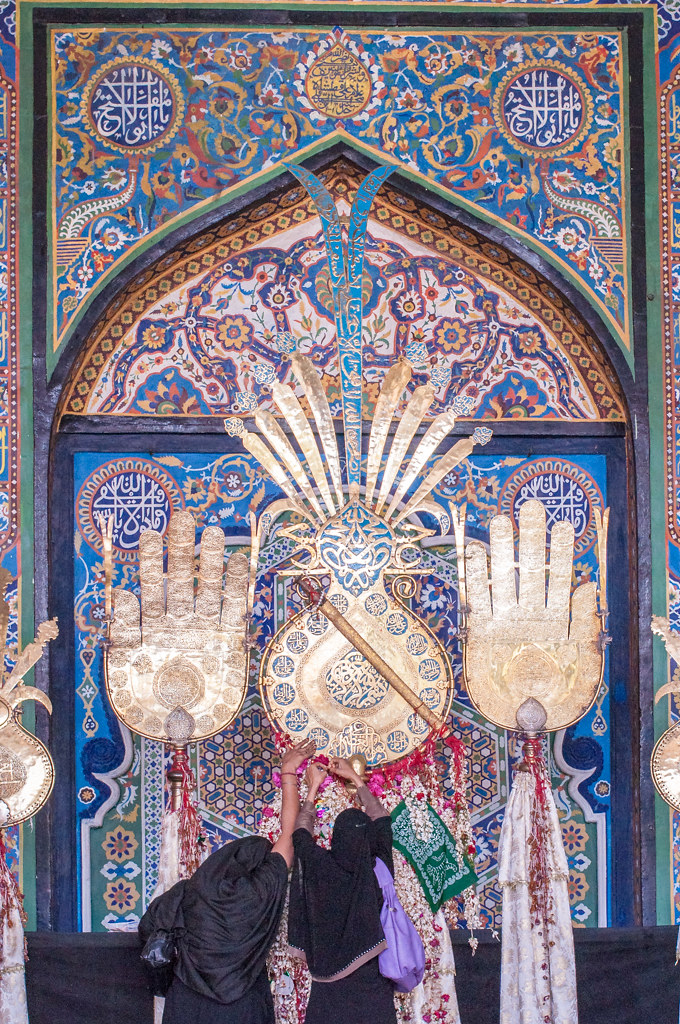
Badshahi Ashurkhana by Saurabh Chatterjee SIA Photography, image from Wikipedia Commons/CC BY-NC-SA 2.0
References
-K., Michell, G. (2016). Badami, Aihole, Pattadakal. India: Jaico Publishing House.
-Kannal, Deepak. Ellora, an Enigma in Sculptural Styles. India: Books & Books, 1996.
-Dhavalikar, M. K. Kailasa — the stylistic development and chronology. Bulletin of the Deccan College Research Institute 41 (1982): 33–45.

